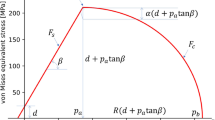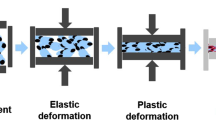Abstract
This study presents a new approach to model powder compression during tableting. The purpose of this study is to introduce a new discrete element simulation model for particle–particle bond formation during tablet compression. This model served as the basis for calculating tablet strength distribution during a compression cycle. Simulated results were compared with real tablets compressed from microcrystalline cellulose/theophylline pellets with various compression forces. Simulated and experimental compression forces increased similarly. Tablet-breaking forces increased with the calculated strengths obtained from the simulations. The calculated bond strength distribution inside the tablets showed features similar to those of the density and pressure distributions in the literature. However, the bond strength distributions at the center of the tablets varied considerably between individual tablets.









Similar content being viewed by others
References
Santos HMM, Sousa JJMS. Pharmaceutical manufacturing handbook: production and processes. USA: Wiley; 2008.
Alderborn G, Nyström C. Pharmaceutical powder compaction technology. New York: Marcel Dekker; 1996.
Carstensen JT. Advanced pharmaceutical solids. New York: Marcel Dekker; 2001.
Morehead WT. Viscoelastic behavior of pharmaceutical materials during compaction. Drug Dev Ind Pharm. 1992;18(6–7):659–75.
Mitrevej A, Faroongsarng D, Sinchaipanid N. Compression behavior of spray dried rice starch. Int J Pharm. 1996;140(1):61–8.
Guo HX, Heinämäki J, Yliruusi J. Characterization of particle deformation during compression measured by confocal laser scanning microscopy. Int J Pharm. 1999;18(6–7):99–108.
Antikainen O, Yliruusi J. Determining the compression behavior of pharmaceutical powders from the force–distance compression profile. Int J Pharm. 2003;252(1–2):253–61.
Kettenhagen WR. Process modeling in the pharmaceutical industry using the discrete element method. J Pharm Sci. 2008;98(2):442–70.
Cunningham JC, Sinka IC, Zavaliangos A. Analysis of tablet compaction. I. Characterization of mechanical behavior of powder and powder/tooling friction. J Pharm Sci. 2004;93(8):2022–39.
Sinka IC, Cunningham JC, Zavaliangos A. Analysis of tablet compaction. II. Finite element analysis of density distribution in convex tablets. J Pharm Sci. 2004;93(8):2040–53.
Khoei AR. An integrated software environment for finite element simulation of powder compaction processes. Materials Processing Technology. 2002;130–131:168–74.
Khoei AR, Azami AR, Azizi S. Computation modeling of 3D powder compaction processes. Materials Processing Technology. 2007;185:166–72.
Wu CY, Bentham AC, Hancock BC, Best SM, Elliott JA. Modelling the mechanical behaviour of pharmaceutical powders during compaction. Powder Technol. 2005;152:107–17.
Wu CY, Hancock BC, Mills A, Bentham AC, Best SM, Elliot JA. Numerical and experimental investigation of capping mechanism during pharmaceutical tablet compaction. Powder Technol. 2008;181:121–29.
Michrafy A, Dodds JA, Kadiri MS. Wall friction in the compaction of pharmaceutical powders: measurement and effect on the density distribution. Powder Technol. 2004;148(1):53–5.
Hassanpour A, Ghadiri M. Distinct element analysis and experimental evaluation of the Heckel analysis of bulk powder compression. Powder Technol. 2004;141:251–61.
Samimi A, Hassanpour A, Ghadiri M. Single and bulk compression of soft granules: experimental study and DEM evaluation. Chem Eng Sci. 2005;60:3993–4004.
Mehrotra A, Chaudhuri B, Faqih A, Tomassone MS, Muzzio FJ. A modelling approach for understanding effects of powder flow properties on tablet weight variability. Powder Technol. 2009;188:295–300.
Sheng Y, Lawrence CJ, Briscoe BJ. Numerical studies of uniaxial powder compaction process by 3D DEM. Eng comput. 2003;21(2/3/4):304–17.
Procopio AT, Zavaliangos A. Simulation of multi-axial compaction of granular media from loose to high relative densities. J Mech Phys Solids. 2005;53:1523–51.
Golchert D, Moreno R, Ghadiri M, Litster J. Effect of granule morphology on breakage behaviour during compression. Powder Technol. 2004;143–144:84–96.
Antonyuk S, Palis S, Heinrich S. Breakage behaviour of agglomerates and crystals by static loading and impact. Powder Technol. 2011;206(1–2):88–98.
Khanal M, Schubert W, Tomas J. DEM simulation of diametral compression test on particle compounds. Granular Matter. 2005;7:83–90.
Hiestand EN. Tablet bond. I. A theoretical model. Int J Pharm. 1991;67:217–29.
Hiestand EN, Smith DP. Tablet bond. II. Experimental check of model. Int J Pharm. 1991;67:231–46.
Siiriä S, Yliruusi J. Particle packing simulations based on Newtonian mechanics. Powder Technol. 2007;174:82–92.
Johansson B, Wikberg M, Ek R, Alderborn G. Compression behaviour and compactability of microcrystalline cellulose pellets in relationship to their pore structure and mechanical properties. Int J Pharm. 1995;117(1):57–73.
Johansson B, Alderborn G. Degree of pellet deformation during compaction and its relationship to the tensile strength of tablets formed of microcrystalline cellulose pellets. Int J Pharm. 1996;132(1–2):207–20.
Salako M, Podczeck F, Newton JM. Investigations into the deformability and tensile strength of pellets. Int J Pharm. 1998;168(1):49–57.
Eriksson M, Alderborn G. The effect of particle fragmentation and deformation on the interparticulate bond formation process during powder compaction. Pharm Res. 1995;12:1031–9.
Nayak PR. Random process model of rough surfaces in plastic contact. Wear. 1973;26(3):305–33.
Podczeck F, Newton JM. The evaluation of a three-dimensional shape factor for the quantitative assessment of the sphericity and surface roughness of pellets. Int J Pharm. 1995;124(2):253–9.
Sebhatu T, Alderborn G. Relationships between the effective interparticulate contact area and the tensile strength of tablets of amorphous and crystalline lactose of varying particle size. Eur J Pharm Sci. 1999;8(4):235–42.
Stanley P. Mechanical strength testing of compacted powders. Int J Pharm. 2001;227(1–2):27–38.
Fell JT, Newton JM. Determination of tablet strength by the diametral-compression test. J Pharm Sci. 1970;59(5):688–91.
Hellen L, Yliruusi J. Process variables of instant granulator and spheroniser: III. Shape and shape distribution of pellets. Int J Pharm. 1993;96:217–23.
Train D. Transmission of forces through a powder mass during the process of pelleting. Trans Inst Chem Eng. 1957;35:258–66.
Macleod HM, Marshall K. The determination of density distributions in ceramic compacts using autoradiography. Powder Technol. 1977;16:107–22.
EIliazadeh B, Briscoe BJ, Sheng Y. Investigating density distributions for tablets of different geometry during the compaction of pharmaceuticals. Part Sci Technol. 2003;21:303–16.
Frenning G. Analysis of pharmaceutical powder compaction using multiplicative hyperelasto-plastic theory. Powder Technol. 2007;172:103–12.
Morisseau KM, Rhodes CT. Near-infrared spectroscopy as a nondestructive alternative to conventional tablet hardness testing. Pharm Res. 1997;14:108–11.
Krieger M, Fähler FJ, Baumgartner K. Determination of tablet hardness with strain gauge equipped instruments. Drug Dev Ind Pharm. 1995;21(19):2201–12.
Dahima R, Pachori A, Netam S. Formulation and evaluation of mouth dissolving tablet containing amlodipine besylate solid dispersion. International Journal of ChemTech Research. 2010;2(1):706–15.
Author information
Authors and Affiliations
Corresponding author
Electronic supplementary material
Below is the link to the electronic supplementary material.
(MPEG 4888 kb)
(MPEG 1462 kb)
(MPEG 3504 kb)
Rights and permissions
About this article
Cite this article
Siiriä, S.M., Antikainen, O., Heinämäki, J. et al. 3D Simulation of Internal Tablet Strength During Tableting. AAPS PharmSciTech 12, 593–603 (2011). https://doi.org/10.1208/s12249-011-9623-0
Received:
Accepted:
Published:
Issue Date:
DOI: https://doi.org/10.1208/s12249-011-9623-0




